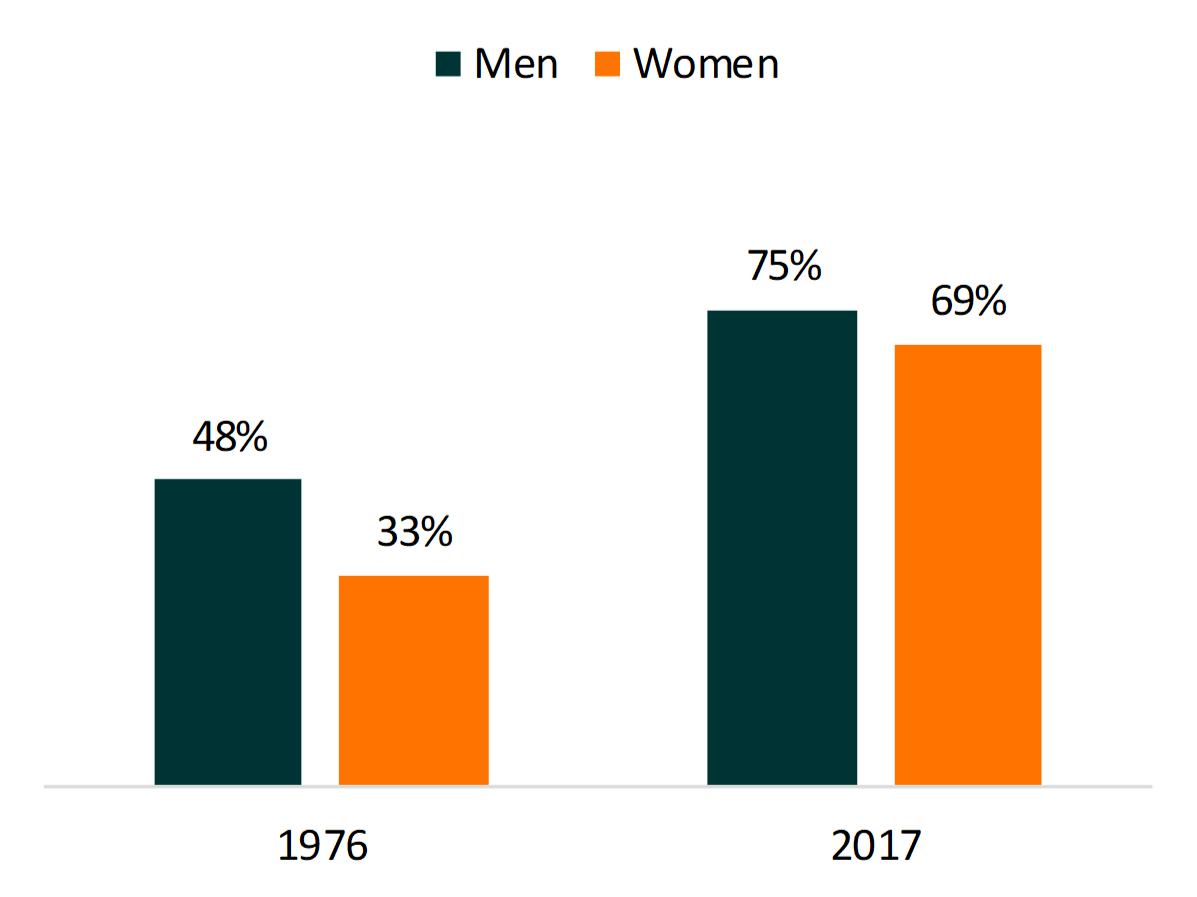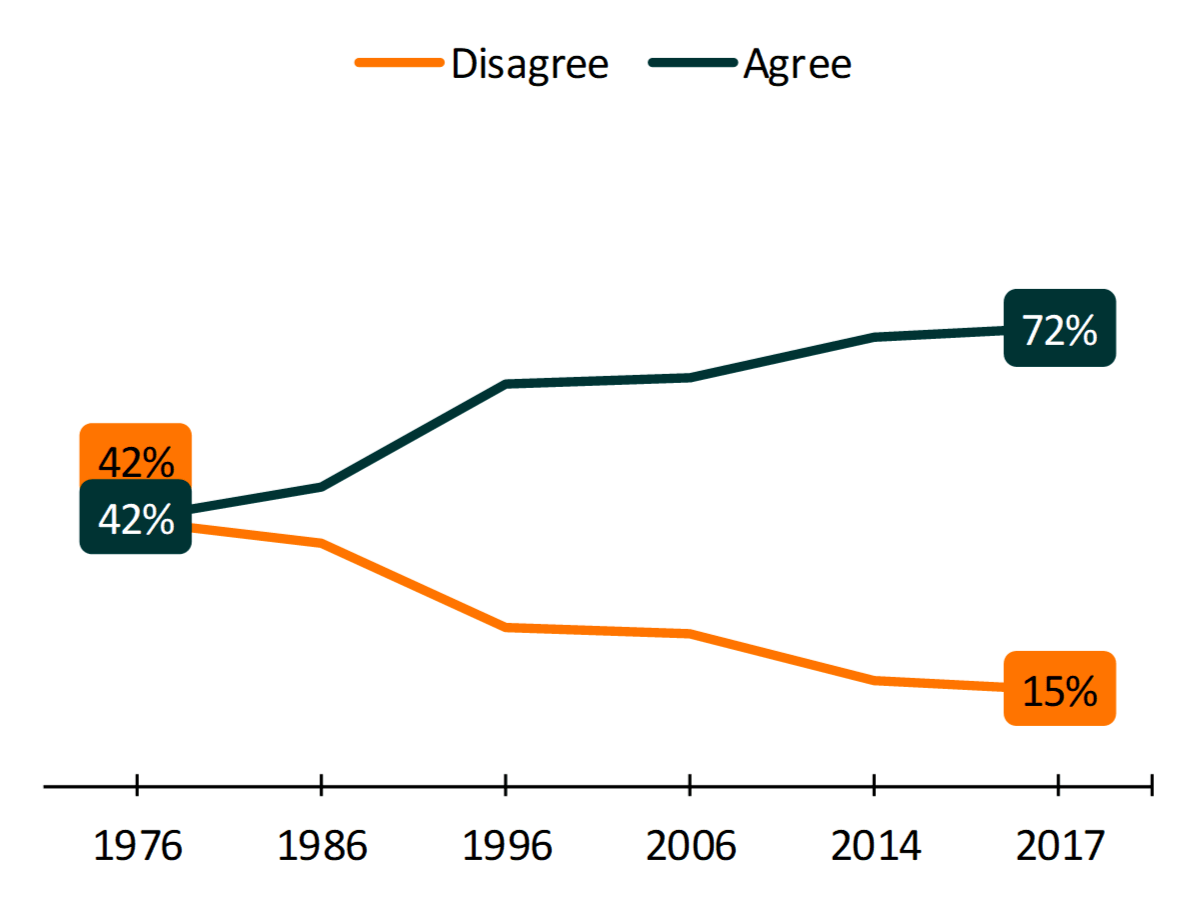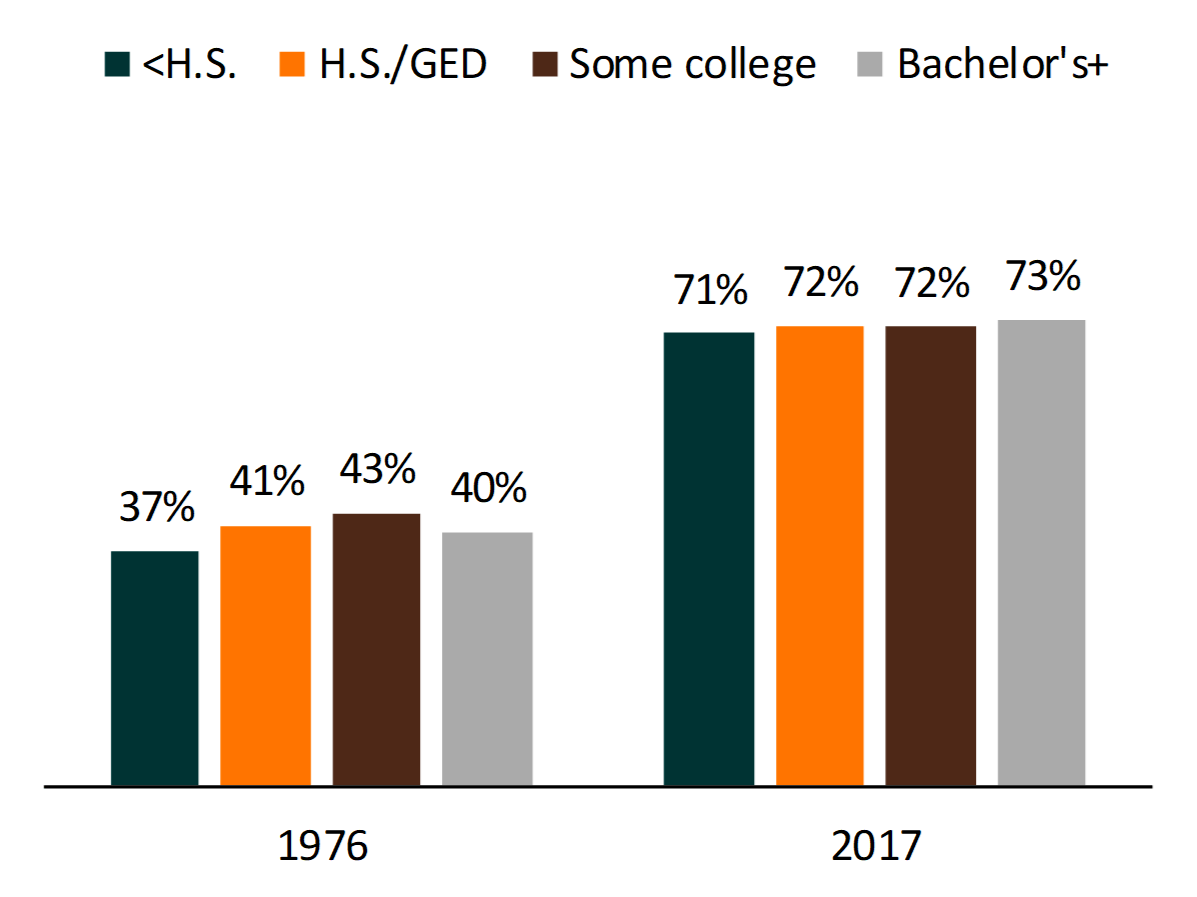High School Seniors’ Attitudes Toward Cohabitation as a Testing Ground for Marriage, 2017
Family Profile No. 10, 2019
Author: Colette Allred
As the average age at first marriage continues to rise in the U.S., the number of adults in premarital cohabiting relationships has increased as well (FP-17-22; FP-17-02). Between the early 1980s and the early 2010s, the share of women who cohabited with their first husband prior to marriage increased by 75% (FP-17-05). Accompanying this shift in behavior is a shift in attitudes. Using Monitoring the Future data, this profile examines four decades of change in high school seniors’ attitudes toward cohabitation as a testing ground for marriage. The attitude measure is based on respondents’ agreement or disagreement (neutral responses are not shown) with the statement “It is usually a good idea for a couple to live together before getting married in order to find out whether they really get along.” This profile is an update of analyses using 2014 data (FP-16-13) and is the first in a three-part series analyzing high school seniors’ attitudes toward and expectations regarding cohabitation and marriage.
Attitudes Toward Cohabitation as a Testing Ground for Marriage Over Time
- The share of high school seniors who agreed with the notion of cohabitation as a testing ground for marriage continuously increased over the past 40 years.
- While roughly equal portions of high school seniors in 1976 agreed or disagreed about whether cohabitation as a testing ground for marriage was a good idea, seven in ten agreed and less than two in ten disagreed by 2017.
Figure 1. High School Seniors’ Attitudes Toward Cohabitation as a Testing Ground for Marriage, 1976-2017
Source: NCFMR analyses of Monitoring the Future, 1976-2017
Attitudes Toward Cohabitation as a Testing Ground for Marriage by Parental Educational Attainment
- The share of high school seniors who agreed with cohabitation as a testing ground for marriage increased across all four categories of parental education between 1976 and 2017.
- In 1976 and 2017, those whose parents had less than a high school education least often agreed with cohabitation as a testing ground for marriage.
- At 73%, a slightly higher portion of those whose parents had at least a bachelor’s degree in 2017 agreed with cohabitation as a testing ground for marriage in comparison to those whose parents had lower levels of educational attainment. In 1976, the highest share was among those whose parents had some college education.
Figure 2. High School Seniors’ Agreement with Cohabitation as a Testing Ground for Marriage by Parental Education, 2017
Source: NCFMR analyses of Monitoring the Future, 1976 & 2017
Attitudes Toward Cohabitation as a Testing Ground for Marriage by Gender
- More young men were agreeable with cohabitation as a testing ground for marriage than young women in 1976 and in 2017, although the gender gap has decreased over time.
- While barely half of young men and a third of young women agreed with cohabitation as a testing ground for marriage in 1976, close to three-quarters of young men and women were in favor in 2017.
Figure 3. High School Seniors’ Agreement with Cohabitation as a Testing Ground for Marriage by Gender, 2017

Source: NCFMR analyses of Monitoring the Future, 1976 & 2017

What is the Monitoring the Future project?
Monitoring the Future: A Continuing Study of American Youth (MTF) began in 1975 as a repeated annual survey on values, attitudes, and lifestyle orientations of high school seniors in the U.S. The most recent data represent the experiences of students in 2017. Each year, a nationally representative sample of 12th graders completes the survey, producing 40+ years of annual snapshots of high school seniors. Additionally, a subset of each annual sample is reinterviewed biannually for twelve years and every five years thereafter producing longitudinal data. MTF also examines the experiences of young adolescents. Since 1991, MTF has included nationally representative samples of 8th through 10th graders.
References
- Eickmeyer, K. J., Payne, K. K., Brown, S. L., & Manning, W. D. (2017). Crossover in the median age at first marriage and first birth: Thirty-Five years of change. Family Profiles, FP-17-22. Bowling Green, OH: National Center for Family & Marriage Research. https://www.bgsu.edu/ncfmr/resources/data/family-profiles/eickmeyer-payne-brown-manning-crossover-age-first-marriage-birth-fp-17-22.html
- Hemez, P. & Manning, W. D. (2017). Thirty years of change in women’s premarital cohabitation experience. Family Profiles, FP-17-05. Bowling Green, OH: National Center for Family and Marriage Research. https://www.bgsu.edu/ncfmr/resources/data/family-profiles/hemez-manning-30yrs-change-women-premarital-cohab-fp-17-05.html
- Hemez, P. & Manning, W. D. (2017). Over twenty-five years of change in cohabitation experience in the U.S., 1987-2013. Family Profiles, FP17-02. Bowling Green, OH: National Center for Family and Marriage Research. https://www.bgsu.edu/ncfmr/resources/data/familyprofiles/hemez-manning-25-years-change-cohabitation-fp-17-02.html
Suggested Citation
- Allred, C. (2019). High school seniors’ attitudes toward cohabitation as a testing ground for marriage, 2017. Family Profiles, FP-19-10. Bowling Green, OH: National Center for Family & Marriage Research. https://doi.org/10.25035/ncfmr/fp-19-10.
This project is supported with assistance from Bowling Green State University. From 2007 to 2013, support was also provided by the U.S. Department of Health and Human Services, Office of the Assistant Secretary for Planning and Evaluation. The opinions and conclusions expressed herein are solely those of the author(s) and should not be construed as representing the opinions or policy of any agency of the state or federal government.
Updated: 04/06/2021 02:04PM





